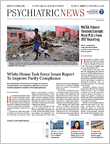After more than two years of planning, refining, and listening to scientific feedback (
Psychiatric News,
December 18, 2014), institutions across the United States began enrolling children for the National Institute of Health’s Adolescent Brain Cognitive Development (ABCD) study this past September. The trial will track the biological and behavioral development of more than 10,000 children, starting at age 9 and 10 for at least 10 years—through adolescence and young adulthood.
A total of 19 research sites across the United States are participating in this study, which will combine brain imaging data, cognitive and behavioral assessments, and other biometric measures including heart rate and sleep patterns as part of a comprehensive data collection process. The participants will also periodically provide biological samples including DNA, and 800 twin pairs will be included among the 10,000 enrollees to provide additional hereditary information.
“This is a unique, ambitious, and exciting initiative that will help us better understand how diverse childhood experiences interact with genetics to influence multiple parameters including behavior, temperament, physical and mental health, and academic performance,” said David Fassler, M.D., a child and adolescent psychiatrist and professor at the University of Vermont College of Medicine. The University of Vermont is one of the 19 research sites selected for the study, but Fassler is not involved in the project.
“Hopefully, the findings will enhance our ability to promote resilience and better identify potential problems as early as possible,” he continued.
Recruitment for the study will take place over the next two years, with the research sites leveraging partnerships with members of surrounding school systems (public, private, charter, and home schools) to encourage a broad range of families to enroll.
Traditional engagement methods by clinical trials can often skew the demographic composition of participants, but the one place where children of all backgrounds are represented is the educational system, said Terry Jernigen, Ph.D., the director of the Center for Human Development at the University of California, San Diego, and co-director of the ABCD Coordinating Center, which is hosted at UCSD.
“For a study of this size and duration, it is imperative that the participants mirror the population of U.S. children as a whole, whether in gender, ethnicity, or culture,” Jernigen told Psychiatric News. “The answers that we get need to be relevant to kids in every community across the country.”
To make the study as reflective of children living in the United States as possible, children with attention, behavioral, or learning problems can enroll so long as the children can reasonably handle the rigor of the various neuropsychological and imaging assessments.
Jernigen noted that a major emphasis of the ABCD study is to uncover the biological and behavioral risk factors that contribute to mental illness and substance use, which frequently manifests during adolescence and early adulthood. Including children with behavioral challenges in the study may help to answer questions regarding the extent to which early-life problems are signs and symptoms of future disorders, she said.
“That is just one of the mysteries we can answer with this prospective, longitudinal study that we couldn’t with any other study design,” said Gaya Dowling, Ph.D., director of the ABCD project at the National Institute on Drug Abuse.
“In addition, ABCD will generate a lot of questions that other scientific studies can answer,” she continued.
That’s why ABCD will employ an open science model with robust data sharing. Dowling told Psychiatric News that the study aims to release raw imaging data every month that the scientific community can make use of, as well as yearly releases of curated data.
“Getting this information to the public is important, as we believe ABCD can uncover actionable information that pediatricians, mental health specialists, educators, and parents can use to help the next generation of children,” she said.
“From my perspective as a child and adolescent psychiatrist, I think this is exactly the kind of large-scale study we need,” echoed Fassler. “I’m optimistic that the results will have a significant impact on clinical practice and public policy for decades to come.” ■
More information on the ABCD study can be accessed
here.

